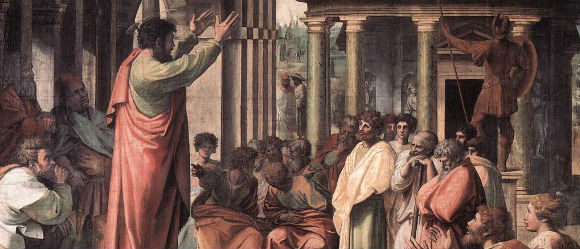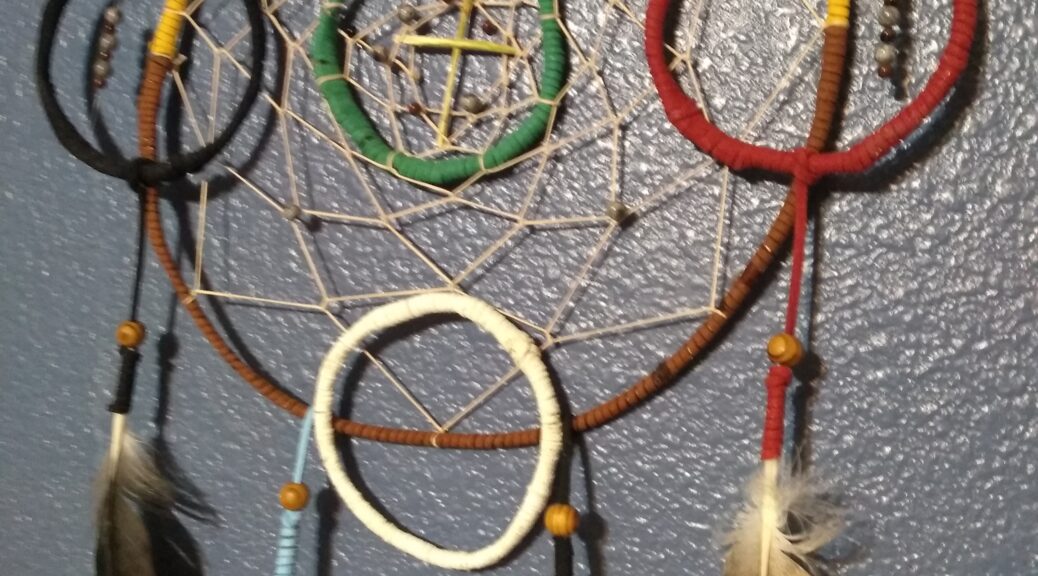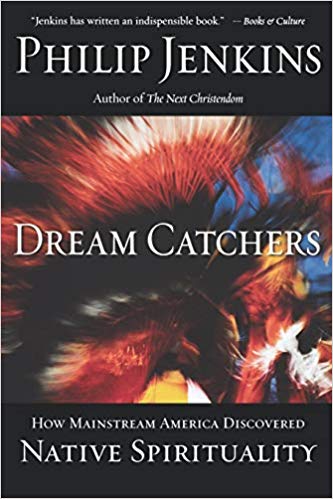In the book of Ephesians, St. Paul encourages two vastly different cultural groups to come together as one body. Though it is easy to skim over, this encouragement was – and is – HUGE! Think about it: Paul isn’t saying that the Greek-Romans have to give up their culture to become like the Jews; nor does he say that the Jews have to give up their culture to be like the Greek-Romans. Rather he is calling for both groups to embrace the discomfort that comes with having two cultures intermingled as one. Powerful teaching that is need today more than ever before! Learn more about this topic in the below video as we look to become one body with multiple cultures.
Tag Archives: Christianity
Cherokee Seven Direction Dreamcatcher
For the past few years I have been sitting with the Cherokee concepts of seven directions. I knew that I wanted to create something to physically represent the concepts held within these seven directions. However I couldn’t quite figure out how to do this….then during a Labor Day backpacking trip, things just fell into place with a picture of what could be. Though the final result was a bit different, the concepts and points given to me by the Creator on that trip stayed the same. And with that, I would like to share the seven directions with you all. =)
The Seven Directions
Like a lot of Indigenous people across Tuttle Island (i.e. North America), the Cherokees assigned a color and a meaning to each the four cardinal directions:
- East -> red -> success; triumph
- North -> blue -> defeat; trouble
- West -> black -> death
- South -> white -> peace; happiness
What is unique (at least as far as I’ve been able to determine) is that the Cherokees recognize three other directions:
- Above -> yellow -> the sky above
- Below -> brown -> the earth below
- Center -> green -> where we are right now
Though I’m still researching the symbolism of the latter three, I do know that ‘above’ doesn’t represent ‘heaven’ nor does ‘below’ represent ‘hell.’ Heaven and hell are Greco Roman concepts that were combined with Hebraic thought through the move of Christianity into Europe. Cherokee cosmology has a different outlook on those directions of which I have barely scratched. Hopefully I will be able to understand more about them as time goes on…but for now just know that ‘above’ and ‘below’ are separate from the modern cultural concepts of ‘heaven’ and ‘hell.’
Praying to the Directions
For a lot of Indigenous people prayers physical in nature. We will commonly turn to the four directions (east, west, north, & south) while praying to the Creator. It is a way to physically connect with our surroundings while lifting our voice to the Lord. I would connect this to the ancient Hebraic practice of sacrifices or the offering of incenses at the Temple. Both practices include a physical action in conjunction with prayers to the Creator. Modern Christian practices along these lines include prayer walking, pacing during prayer meetings, dancing, flag waving, clapping, etc. The primary difference being, of course, that these latter actions aren’t necessarily done in a specific order whereas praying to the directions includes turning to face a certain direction before saying a prayer.
In pondering the seven directions of the Cherokees, there have been times when I have physically faced each of the directions while giving thanks to the Creator. Though it seemed strange at first, there is something refreshing about having a physical response to act out while praying. It is also a good reminder that Jesus surrounds and protects us from harm in all directions. I would liken it to Saint Patrick’s Breastplate:
Christ with me, Christ before me,
Christ behind me, Christ within me,
Christ beneath me, Christ above me,
Christ at my right, Christ at my left,
The 8th section of Saint Patrick’s Breastplate
Dreamcatchers
As you all no doubt noticed from the title and below picture, the end result of my art project was a seven direction dreamcatcher. This was because the circular structure of the dreamcatcher just seemed to fit with the theme and concepts I wanted to convey. Historically dreamcatchers are from the Ojibwe people of the Great Lake region and southern Canada. They were adopted as a generic symbol of identification for Native Americans/First Nations cultures during the Pan-Indian Movement of the 1960s/70s. The mainstream public also started seeing them around this time with dreamcatchers being a craft item in the 80s and 90s.
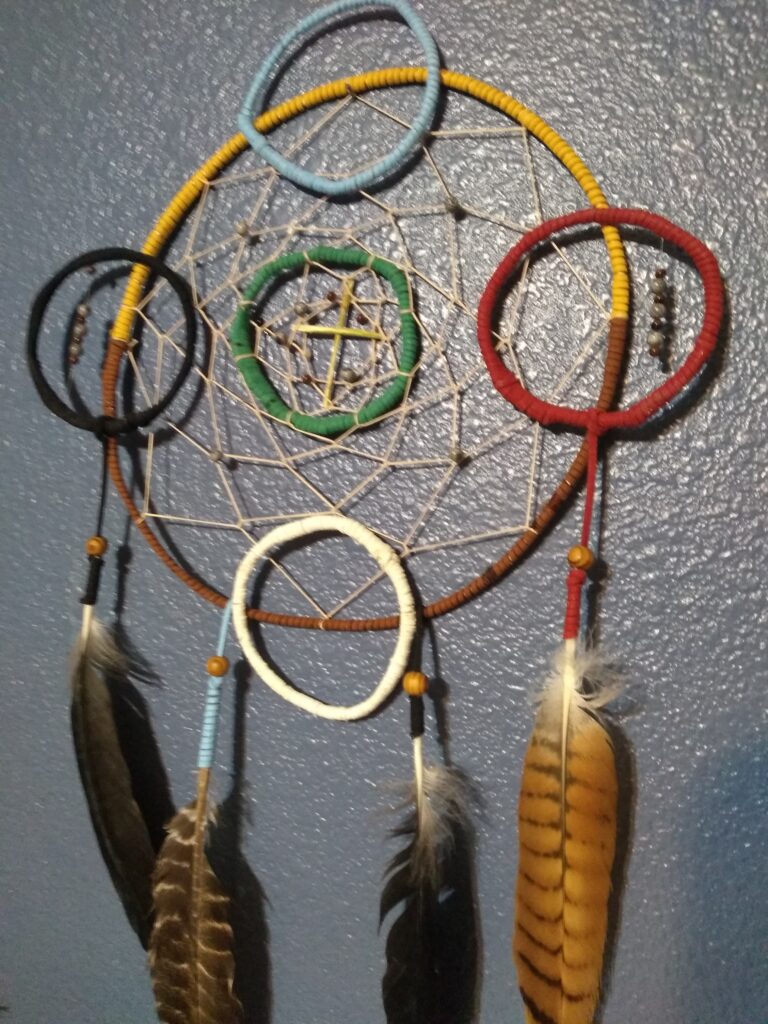
Among the Ojibwe people, dreamcatchers were associated with Asibikaashi (Spider Women) who would protect them from harm by weaving a spider web around them. Hence the spider web design of the dreamcatchers. Noting, of course, that the Ojibwe concept was less about dreams and more about protection from harm in general. The dream component became attached to the object as it went out from the Ojibwe to the rest of the country.
Though I’m not one for charms, I do like the symbolism of the dreamcatcher with protection. It goes back to Saint Patrick’s Breastplate and the prayers to the seven directions for Christ to surround us with his protection. Psalm 91 would be a good example of prayers of this type as would Psalm 139. This latter psalm, by the way, includes several of the seven directions as King David declares the presence of the Creator around himself:
You know when I sit and when I rise;
you perceive my thoughts from afar.
You discern my going out and my lying down;
you are familiar with all my ways.
Before a word is on my tongue
you, Lord, know it completely.
You hem me in behind and before,
and you lay your hand upon me.
Psalm 139:2-5, NIV
The Materials
I have often said that the way in which you do something is just as important as what you do. In this case, I sought out seven different biological materials to form the foundations of my seven direction dreamcatcher. Circles were used as a primary design motif due to the symbolism of circles in the cycle of the seasons, life, time, and nature itself. I initially wanted seven circles (one per direction) but in the end I went with six circles due to the ease of construction and overall look.
The rings themselves are made of the following materials:
- East -> pine -> One of the few trees who stayed awake throughout the seven days of the Cherokee creation story. Since the east is the direction of creation, I placed the pine ring in that direction.
- North -> aspen -> When I think of the north, aspen trees come to mind as they are native to the colder regions of North America. Hence the placement of this wood.
- West -> sage -> Sage is a ceremonial plant for many Native Americans and is burned when praying as a way to purify oneself. I figured that since the west was the direction of death, it could use some extra prayer and purity.
- South -> corn -> South is the place of happiness and peace to the Cherokee. Hence I used the leaves of the corn plant as the foundation under the white leather in remembrance of Selu the Corn Mother.
- Up Above and Down Below -> willow -> Running through and surrounding the other directions is a large ring of willow which represents Jesus of Nazareth through whom all things that were, are, and will be made (e.g. John 1:3, Col 1:16). The weeping nature of the willow played a part in choosing this wood as Jesus wept over Jerusalem when the people failed to respond to his call to walk with him in peace and love (Luke 19:41-44). Furthermore, willows need a lot of water to survive hence why they are normally found near creeks and rivers. Hence the connection (at least in my mind) with the living water of the Holy Spirit that flows throughout Creation (Revelation 22:1-5).
- Center -> oak -> The oak tree was an important part of Cherokee life with acorns being ground up to make bread, the inner bark used in baskets, and the wood itself used to keep the Sacred Fire alive. Hence the usage of this wood to create the center ring of where each us stands. This is the place where we are; where we live and breathe.
In addition to the six rings, there is a collection of other material used within this dreamcatcher. Below are some thoughts on these items:
- The Weave – At first I wasn’t sure about the weave as dreamcatchers aren’t really my style. However as I thought about it, I like the concept of the Holy Spirit weaving his way throughout the seven directions and within our lives. He is the one, after all, who calls us toward the Cross which is in the center of life (John 14:15-17).
- The Cross – Inside the center ring is a small cross made of spruce. Similar to the pine, the spruce tree stayed awake throughout creation and therefore was blessed with the gift of staying green year-round. The Cross, though bloodied with death and pain, forms the genesis of a new life in and through Jesus. It is a symbol of what was and what is to come.
- Beads – There are seven small beads within the three center circles (west, center, and east). The three larger gray ones are jasper while the four smaller ones are mahogany obsidian. The mahogany obsidian bead represents the blood of Christ that saves us (east), is saving us (center), and one day will save us (west). There are four obsidian beads in each of the three groups of seven for the four gospel letters which tell us the story of Jesus while the total of 12 is for the twelve apostles who walked with Christ. The three jaspers in each group of seven are for the Trinity (Father, Son, and Spirit). Surrounding the center ring within the weave itself are four jasper beads for the four winds that blow across the earth carrying with them the Spirit of the Living Creator (John 3:8).
- Feathers – The feathers are more for me than to share as some things are better left a mystery. Just know that they have a personal meaning that are not connected to the seven directions. =)
Book Review: Dream Catchers: How Mainstream America Discovered Native Spirituality
Some thoughts and reflections on Philip Jenkins’s book Dream Catchers: How Mainstream America Discovered Native Spirituality
“The Essential Rumi” translated by Coleman Barks
 Jalāl al-Dīn Rūmī (Sept. 30, 1207 – Dec. 17, 1273), better known as Rumi, was a Persian born Sufi Muslim teacher, religious leader, poet, and Islamic scholar. Since the day that they were written, Rumi’s poems have been enjoyed by countless people in multiple languages. In recent decades, his poems have enjoyed a renaissance in America with Rumi becoming “one of the best-selling poets in the United States.”[1]
Jalāl al-Dīn Rūmī (Sept. 30, 1207 – Dec. 17, 1273), better known as Rumi, was a Persian born Sufi Muslim teacher, religious leader, poet, and Islamic scholar. Since the day that they were written, Rumi’s poems have been enjoyed by countless people in multiple languages. In recent decades, his poems have enjoyed a renaissance in America with Rumi becoming “one of the best-selling poets in the United States.”[1]
As a Sufi Muslim, Rumi was follower of “Islam’s immensely complex and infinitely diverse mystical tradition.”[2] Though rooted in the core beliefs of Islam, Sufism is a “medley of divergent philosophical and religions trends”[3] with concepts borrowed from Christianity, Hinduism, Buddhism, and other religions. This background allowed Rumi to become “dissolver of boundaries” with poems that speak to the heart of humanity regardless of religious affiliation. This mystical belief in the connection of all of humanity can be seen most clearly in Rumi’s statement that he saw “one altar” and not three when he went “into the Muslim mosque and the Jewish synagogue and the Christian church.”[4]
Rumi’s poems are characterized by his usage of “anything human beings do, no matter how scandalous or cruel or silly, as a lens to examine soul growth.”[5] This style, though effective at one level, also tends to drive away some readers due to the crude and unrefined nature of the poems. I, for one, fall into this latter group as I did not find Rumi’s poems to be enlightening, enriching, or beneficial. Rather I found them to confusing and unhelpful in stimulating personal spiritual formation. Part of this, I readily admit, may be due to my personal preference and enjoyment of prose over and above that of poetry of any nature.
There were two poems of Rumi’s that I did find of interest. The first being the “Chickpea to Cook” in which the chickpea learns from the cook that flavor comes through the heat of the stove.[6] Coleman Barks, the poem’s translator, elaborates on this poem stating that the chickpea is the disciple who listens to and obeys their teacher (i.e. the cook).[7] Though this may be the official scholarly interpretation of the poem, my heart understood the poem along the lines of personal hardship. Spiritual growth, wisdom, and maturity rarely come when life is at its best; rather these things are born out of a heart that allows God to refine us like gold in the melting pot (e.g. Malachi 3:3, James 1:2-4, Isaiah 48:10).
The “Elephant in the Dark” was the second Rumi poem that stood out to me.[8] This poem tells the story of three men who look at an elephant in a dark room. Each one only sees and feels a portion of the elephant and, therefore, comes to an incomplete understanding of the animal. This is most likely one of Rumi’s most famous poem, though he is not always given credit for it. Hence while I have heard multiple variations of this poem over the years, I did not know its author. As such, finding the true author of the poem was like finding a coin in a rain-soaked field, a pleasant surprise that makes the trudge through the mud bearable.
In conclusion, I found the poems of Jalāl al-Dīn Rūmī as translated by Coleman Barks in the book The Essential Rumi interesting though uninspiring. However, I am sure lovers of poetry will most likely disagree with this conclusion as seen by the lasting international fame of Rumi. To each their own.
Endnotes
[1] Azadeh Moaveni, “How Did Rumi Become One of Our Best-Selling Poets?”, The New York Times (New York City, NY), January 20, 2017, accessed February 19, 2018, .
[2] Reza Aslan, No god But God: The Origins, Evolution, and Future of Islam (New York: Random House, 2005), 198.
[3] Reza Aslan, No god But God, 199.
[4] Jalāl al-Dīn Rūmī, The Essential Rumi, trans. Coleman Barks (New York: HarperOne, 2004), 246.
[5] Jalāl al-Dīn Rūmī, The Essential Rumi, 173.
[6] Jalāl al-Dīn Rūmī, The Essential Rumi, 132-133.
[7] Jalāl al-Dīn Rūmī, The Essential Rumi, 132.
[8] Jalāl al-Dīn Rūmī, The Essential Rumi, 152.
No god But God: The Origins, Evolution, and Future of Islam by Reza Aslan
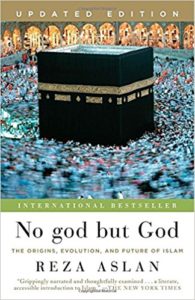 Islam rose to the forefront of the global consciousness on September 11, 2001 through the bloody actions of several self-proclaimed followers of Islam. Yet in spite of the almost constant barrage of information since then by news pundits, political leaders, and religious personalities, it seems that most people living in the United States still don’t understand the basic concepts, history, or divisions within the religion. Written four years after the 9-11 terrorist attacks by Reza Aslan, a Sufi Muslim immigrant to the USA from Iran, the book No god But God: The Origins, Evolution, and Future of Islam seeks to provide the reader with a basic understanding of Islam.[1]
Islam rose to the forefront of the global consciousness on September 11, 2001 through the bloody actions of several self-proclaimed followers of Islam. Yet in spite of the almost constant barrage of information since then by news pundits, political leaders, and religious personalities, it seems that most people living in the United States still don’t understand the basic concepts, history, or divisions within the religion. Written four years after the 9-11 terrorist attacks by Reza Aslan, a Sufi Muslim immigrant to the USA from Iran, the book No god But God: The Origins, Evolution, and Future of Islam seeks to provide the reader with a basic understanding of Islam.[1]
Using chronological time as a scaffold, Aslan focuses on telling the theological history of Islam rather than outlining the territorial spread of the religion. This focus on the theological development of Islam allows Aslan to highlight the various reformation movements within the religion. In fact, Aslan goes as far as to say that the book itself is less about the origins of Islam as much as it is “an argument for reform.”[2] Though not widely known in the United States, “Islam has been in a constant state of evolution”[3] since the very beginning. Hence the power and glory of Aslan’s book is that it informs the readers of the struggles within Islam as its religious followers try to adapt their religion to a changing world while remaining true to their traditions, scriptures, and deity.
A good example of this struggle is the ongoing debate over the role of human reason in reading and understanding the Quran. The Rationalist school of thought within Islam believes that all “theological arguments must adhere to the principles of rational thought.”[4] Hence to them, the proper way to interpret the Quran is to read it within “its historical context.”[5] This allows proponents of the Rationalist school of thought to adapt the message of the Quran to the culture of the time. The Traditional school of thought, however, holds the opposite view, claiming that “human reason, while certainly important, must nevertheless be subordinate to the Quran and the Sunna of the Prophet.”[6] This view leads to a more literal reading of the Quran that states that the Quran and its interpretation “has never changed and will never change.”[7]
This debate reminds me of the Liberal/Fundamentalist divide within Protestant Christianity in the United States. Within this divide it was the Liberals who embraced science and human logic while the Fundamentalists held to a “strong emphasis on the inerrancy and literal truth of the biblical record and the falseness of modern, skeptical, evolutionary science and philosophy.”[8] As such, it can be said that Fundamental Evangelicalism and Traditional Islam both hold to some of the same philosophical concepts.
In closing, I must admit that I thoroughly enjoyed Reza Aslan’s book No god But God: The Origins, Evolution, and Future of Islam. It gave me a greater understanding of what is happening within Islam and among the various people groups who embrace the teachings of Muhammad. As the last decade has taught us, the world is changing with Islam quickly becoming a major player on the global scene. Accordingly, the reforms within Islam have now become the reforms of all people as these reforms have the potential to shape the world’s geopolitical and cultural structures in multiple ways.
Endnotes
[1] “Reza Aslan,” Wikipedia, The Free Encyclopedia, accessed on January 1, 2018.
[2] Reza Aslan, No god But God: The Origins, Evolution, and Future of Islam (New York: Random House, 2005), xx.
[3] Reza Aslan, No god But God, 266.
[4] Reza Aslan, No god But God, 153.
[5] Reza Aslan, No god But God, 161.
[6] Reza Aslan, No god But God, 153.
[7] Reza Aslan, No god But God, 161.
[8] Roger E. Olson, The Story of Christian Theology: Twenty Centuries of Tradition and Reform (Downers Grove, Illinois: InterVarsity Press, 1999), 534.

